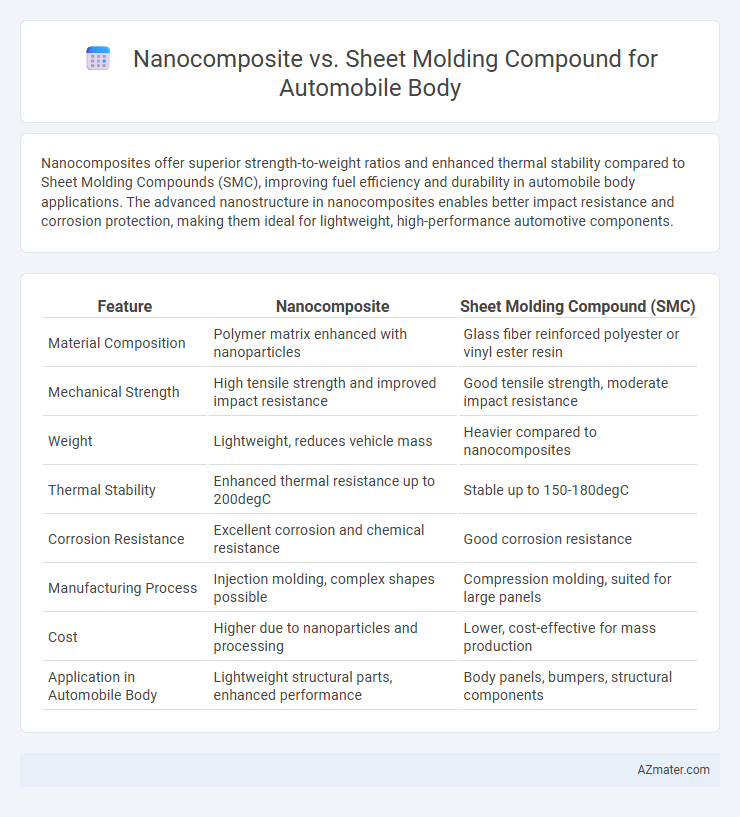Nanocomposites offer superior strength-to-weight ratios and enhanced thermal stability compared to Sheet Molding Compounds (SMC), improving fuel efficiency and durability in automobile body applications. The advanced nanostructure in nanocomposites enables better impact resistance and corrosion protection, making them ideal for lightweight, high-performance automotive components.
Table of Comparison
| Feature | Nanocomposite | Sheet Molding Compound (SMC) |
|---|---|---|
| Material Composition | Polymer matrix enhanced with nanoparticles | Glass fiber reinforced polyester or vinyl ester resin |
| Mechanical Strength | High tensile strength and improved impact resistance | Good tensile strength, moderate impact resistance |
| Weight | Lightweight, reduces vehicle mass | Heavier compared to nanocomposites |
| Thermal Stability | Enhanced thermal resistance up to 200degC | Stable up to 150-180degC |
| Corrosion Resistance | Excellent corrosion and chemical resistance | Good corrosion resistance |
| Manufacturing Process | Injection molding, complex shapes possible | Compression molding, suited for large panels |
| Cost | Higher due to nanoparticles and processing | Lower, cost-effective for mass production |
| Application in Automobile Body | Lightweight structural parts, enhanced performance | Body panels, bumpers, structural components |
Introduction to Automotive Lightweight Materials
Nanocomposites offer enhanced mechanical properties and weight reduction compared to traditional materials, making them ideal for automotive lightweight applications. Sheet molding compounds (SMCs), composed of reinforced resins, provide excellent moldability and surface quality but generally have higher density and lower strength-to-weight ratios than nanocomposites. The integration of nanocomposite materials in automobile bodies significantly improves fuel efficiency and vehicle performance by reducing structural weight while maintaining crashworthiness.
What are Nanocomposites?
Nanocomposites are advanced composite materials characterized by the incorporation of nanoparticles into a matrix, enhancing mechanical, thermal, and barrier properties at the nanoscale. In automobile body applications, nanocomposites offer superior strength-to-weight ratios, improved impact resistance, and increased durability compared to conventional sheet molding compounds (SMC). These enhanced properties enable lighter vehicle designs, contributing to increased fuel efficiency and reduced emissions without compromising structural integrity.
Overview of Sheet Molding Compound (SMC)
Sheet Molding Compound (SMC) is a fiber-reinforced composite material widely used in automobile body panels due to its high strength-to-weight ratio and excellent surface finish. It consists of a thermoset polymer matrix, typically unsaturated polyester resin, combined with chopped fiberglass and fillers, molded under heat and pressure to produce durable, corrosion-resistant parts. The material's ability to be easily molded into complex shapes and its superior impact resistance make SMC a preferred choice for lightweight automotive body components compared to traditional materials.
Key Properties: Nanocomposites vs. SMC
Nanocomposites exhibit superior mechanical strength, enhanced thermal stability, and improved corrosion resistance compared to Sheet Molding Compound (SMC), making them ideal for lightweight and durable automobile body parts. SMC offers excellent moldability, cost-effectiveness, and uniform surface finish, but it generally lacks the nanoscale reinforcement that boosts performance metrics in nanocomposites. The integration of nanomaterials in composites leads to higher stiffness-to-weight ratios and better impact resistance, vital for automotive safety and efficiency.
Manufacturing Processes and Scalability
Nanocomposites for automobile bodies utilize advanced manufacturing processes such as melt blending and in situ polymerization, enabling superior mechanical properties and lightweight structures but often require precise control and longer processing times. Sheet molding compounds (SMC) employ compression molding with preformed fiber-reinforced sheets, offering faster cycle times, high volume scalability, and cost-effective mass production. Scalability favors SMC due to established industrial infrastructure and quicker mold cycle times, while nanocomposites demand enhanced process control for consistent quality in large-scale manufacturing.
Mechanical Performance in Automotive Applications
Nanocomposites exhibit superior mechanical performance in automotive body applications due to their enhanced strength, stiffness, and impact resistance compared to traditional Sheet Molding Compound (SMC). The incorporation of nanoscale fillers such as carbon nanotubes or graphene into polymer matrices results in improved tensile strength, flexural modulus, and fatigue resistance essential for lightweight and durable automotive components. SMCs, while cost-effective and suitable for complex shapes, generally show lower mechanical properties and higher weight, limiting their use in high-performance automotive body structures.
Weight Reduction and Fuel Efficiency
Nanocomposites offer superior weight reduction compared to sheet molding compounds (SMCs) due to their enhanced strength-to-weight ratios, significantly lowering the overall mass of automobile bodies. This reduction directly improves fuel efficiency by decreasing vehicle load, allowing engines to consume less fuel during operation. The integration of nanocomposite materials in automotive manufacturing supports stringent environmental regulations through lighter, more fuel-efficient vehicles.
Cost Analysis and Economic Viability
Nanocomposites offer enhanced mechanical properties and corrosion resistance but typically involve higher raw material and processing costs compared to sheet molding compounds (SMCs), impacting the overall cost efficiency for automobile bodies. SMCs, favored for their lower production costs and established manufacturing processes, provide economic viability in high-volume automotive applications despite comparatively lower performance metrics. The choice between nanocomposites and SMCs hinges on balancing upfront material expenses with long-term benefits such as weight reduction and durability, influencing cost-effectiveness in vehicle production.
Environmental Impact and Recyclability
Nanocomposites in automobile bodies offer enhanced environmental benefits through lightweight materials that reduce fuel consumption and lower CO2 emissions compared to traditional Sheet Molding Compounds (SMC). The recyclability of nanocomposites is advancing with improved separation techniques for nanoparticles, whereas SMC recycling remains challenging due to thermoset matrix limitations and high energy input. Emphasizing sustainable manufacturing, nanocomposites support circular economy goals by enabling material recovery and reuse more efficiently than conventional SMC materials.
Future Trends and Industry Adoption
Nanocomposites, offering superior strength-to-weight ratios and enhanced thermal stability, are increasingly favored in automobile body manufacturing, promising significant fuel efficiency improvements and reduced emissions. Sheet molding compounds (SMCs), valued for cost-effectiveness and ease of mass production, remain dominant in large-scale applications but face competition as nanocomposite technologies mature and scale. Industry adoption trends show a gradual shift toward hybrid materials combining nanocomposites with traditional SMCs to optimize performance, durability, and sustainability in future vehicle designs.

Infographic: Nanocomposite vs Sheet molding compound for Automobile body
 azmater.com
azmater.com